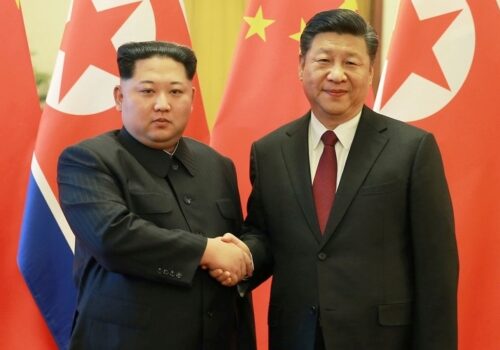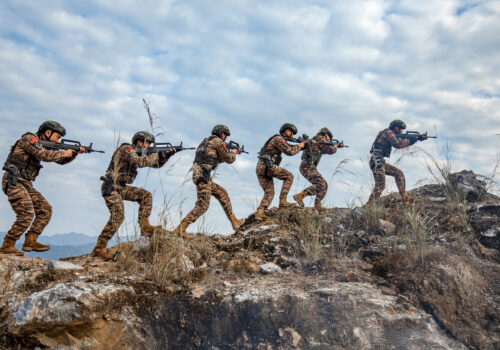Deterring Chinese aggression takes real-time intelligence

Click on the banner above to explore the Tiger Project.
To advance peace through strength, the US military must be capable of denying the People’s Republic of China (PRC) any chance of taking Taiwan by force. This will take more than military modernization. The Trump administration needs to transform the Intelligence Community’s (IC) early-warning capabilities. It’s time to inject unprecedented speed and efficiency into this national mission with a clear goal: attaining real-time awareness across all domains—space, cyberspace, sea, land, and air. Creating this capability is crucial for gathering intelligence against hard targets, understanding emerging events, anticipating the future, and maintaining decision advantage. It’s a tall order, but it’s achievable with the president’s leadership and industry’s cutting-edge tech.
A conflict with the PRC over Taiwan is neither imminent nor inevitable. The PRC has a strategy for annexing Taiwan without an invasion—and it’s in use right now. This strategy has more to do with cyber power than firepower. But the Joint Force and the IC must be prepared for all potential futures—including the risk that the PRC might one day try to blockade or invade Taiwan, sparking a global security crisis.
Operationalize the JWC and JADC2
In the unfortunate event of a future crisis or conflict with the PRC, the IC would need to deliver real-time, decision-quality information advantage in all warfighting domains. The Defense Department’s Joint Warfighting Concept (JWC) theorizes new ways to array the Joint Force with a kill web linking any sensor to any shooter. The enabling Joint All-Domain Command and Control System (JADC2) concept is the holistic underlying approach to link these sensors and associated data into the joint all-domain kill web. For the United States, partners, and allies to operate effectively, the JWC and JADC2 will require those forces to possess real-time information because the side that sees first decides first, and the one that acts first will have the advantage.
If deterrence fails, conflict with the PRC would be unlike any other in history. It would be much faster, more lethal, and more autonomous in an era with swarm technology and hypersonic weapons. It could even include the unthinkable: the use of nuclear capabilities. In addition to combat in the traditional air, land, and sea domains, operations in space and cyberspace would play outsized roles. To be ready to prevail, the entire US intelligence enterprise must rethink and retool how it collects in all domains, and how it uses artificial intelligence (AI) and advanced techniques to analyze and deliver information at speed, enabling JWC/JADC2 in new ways. Speed, timing, and escalation would depend on US and allied reactions, as well as readiness levels and positioning of forces that might be involved. Scenarios involving blockades or an invasion would pose unique challenges to current indication and warning methodologies and models.
Overcome silos that hinder national security
Attaining a real-time, all-domain awareness capability will require a unified effort across the IC, which comprises eighteen independent agencies with authorities to collect, analyze, and report. While some roles and missions overlap, they all have unique capabilities and specified intelligence tasks under Title 50, established laws, and associated IC policy documents. All use different sources, methods, and unique tradecraft to produce intelligence on a variety of national security threats and challenges.
Each agency collects sensitive and restricted information not available to all consumers. Agencies operate on their own top-secret networks and with proprietary software and tools. Each agency partners differently and disseminates intelligence on an as-needed basis (some with more restrictions than others). Each agency has grown its culture, governed its own rice bowls, and competed for scarce resources, creating a competitive atmosphere in the IC that limits collaboration and integration.
To be sure, the IC was highly effective in the lead-up to Russia’s invasion of Ukraine. Time and observables were contributing factors, as Russian force movements were visible months before the invasion and the US military had time to posture for the conflict. At the national level, agile disclosure policies allowed for timely and accurate sharing with partners and allies, empowering a coalition build that enabled rapid military and political support for Ukraine. But it is unlikely that a crisis or conflict with the PRC would unfold in a similar way. The PRC has carefully studied Russian mistakes in Ukraine and is unlikely to repeat them in a Taiwan scenario. Moreover, the proximity of Taiwan to the mainland—combined with the tyrannies of time, distance, and force posture in the region—could create larger dilemmas for the IC.
Proactively strengthen the IC’s posture
All in all, the IC’s preparedness for potential crisis and conflict scenarios involving the PRC has significant room for improvement. The IC has grown incredible capabilities but also daunting bureaucracies that stifle true integration. Combine this with the explosion of information sources, collection techniques, analytical tools, AI advancements, technical hurdles, tradecraft discrepancies, and individual agency priorities, and the result is a lack of unity across the intelligence enterprise. The status quo puts at risk the IC’s ability to see what’s coming in real time—potentially with damaging and cascading consequences.
The IC posture shortfalls are amplified by a lack of information integration across the Department of Defense (DoD). JWC and JADC2 require both intelligence and non-intelligence information sharing at speed for rapid situational understanding and decision advantage. But this underpinning of real-time authoritative intelligence—to see, decide, and act first—does not yet exist. Right now, the IC is inundated with data and tools, but has no way to integrate at scale. It’s time for major changes to the system.
The armed services, intelligence agencies, and many US partners have collection tools and capabilities to identify threats. But if there were a crisis or conflict with the PRC, imagine how many People’s Liberation Army (PLA) objects and targets would be involved. In a conflict scenario, the Joint Force would need a clear integrator of the data streams or multiple intelligence (multi-INT) analysis required to hold all those foreign military objects and targets at risk, or to service those targets kinetically or non-kinetically when required. Such a capability is crucial for deterring and defeating threats.
Avoid governing by crisis
Too often, sweeping changes have come only during or after a great crisis, usually with great loss of life and national embarrassment.
- The 1941 attack on Pearl Harbor resulted in the wartime mass mobilization and the eventual first use of an atomic bomb.
- It took the humiliating failures associated with Operation Eagle Claw in 1980 to drive the wide-ranging reforms in the 1987 Goldwater-Nichols Act, which brought about dramatic improvements at DoD. That statute mandated new doctrine for joint operations, the creation of US Special Operations Command, new ways to educate and manage DoD personnel, and changes in how the US military operates.
- The response to the 9/11 attacks drove comprehensive changes in civil society and national security, culminating in the creation of a new cabinet position to unify the IC and prevent strategic surprise and catastrophic attacks against the United States or its allies and partners.
These changes only occurred with presidential leadership and bipartisan congressional consensus. Otherwise, the United States’ layered governmental bureaucracy, policies, bifurcated political system, and funding process do not normally allow for effective, incremental strategic change. The nation cannot afford to govern by crisis or to rely on twentieth-century-style incremental intelligence reform. Without a strong national mandate, the IC will maintain its current trajectory. That trajectory is inadequate in peacetime and will not suffice in a crisis that leads to conflict.
Integrating intelligence is key
To advance peace through strength, leadership is needed now. The Trump administration has the opportunity to raise public awareness about the range of threats posed by the PRC, Russia, Iran, and North Korea, and to accelerate national security to deal with those threats—particularly by building real-time, all-domain awareness. This awareness can enable the Joint Force to have well-established, rehearsed, and standardized kill chains for credible deterrence. What’s more, it can position the United States to identify and address growing threats in the gray zone—where rivals are trying to compete with the United States without resorting to direct conflict.
In a recent, positive development, the undersecretary of defense for intelligence and security (USD-I&S) signed a directive designating the Defense Intelligence Agency as the “enterprise lead” for the common intelligence picture (CIP). This is a good start. But given the enormity of the task, limited time available, and bureaucratic hurdles, DoD will need to go much further—and that won’t happen without a presidential directive, bipartisan congressional support, and a comprehensive approach spanning DoD, the IC, and industry.
Imagine a nationally mandated and funded project to integrate intelligence from all disciplines to gain and maintain real-time, all-domain awareness across multiple networks and classification levels. Turning this idea into reality is the only way the United States and its allies and partners can proactively seize the initiative, reestablish deterrence, and prevail in the event of conflict. To demonstrate US national resolve and potentially advance strategic deterrence, the high-level commitment to intelligence integration and JADC2 should be highly visible to the PRC and Russia while the sensitive details remain carefully guarded.
The president can drive the change
A presidential directive focused on realizing JWC/JADC2 capabilities to address the PRC threat could empower and drive a “whole of DoD and IC” effort to achieve full operating capabilities with strategic impact. This would strengthen the nation’s competitive edge and position the military and the IC to deliver peace through strength. With ten of the nation’s intelligence agencies under DoD’s umbrella, the secretary of defense should lead this effort in collaboration with the director of national intelligence. This could entail empowering a senior DoD leader such as the USD-I&S with real authority to effect change.
The JWC mandate should require delivery of actionable capabilities within specified timelines, include technical, AI, and tradecraft experimentation, and provide other transaction authority (OTA) or other rapid-acquisition authorities that optimize industry support. For the incoming USD-I&S, the quick stand-up of actionable working groups with deliverables and timelines will be critical. At a minimum, technical, tradecraft, AI, integration, experimentation, and industry work groups should be established. Deputies from each DoD intelligence agency and the services should be assigned to this effort on a full-time basis. Ruthless enforcement of timelines and deliverables by the deputy secretary of defense and USD-I&S will be the only way to effectively lead and direct this effort.
There is no time to lose. Attaining real-time awareness across all domains is vital for national security and defense. With the new administration’s leadership and industry’s cutting-edge tech, transforming early-warning capabilities with real-time, all-domain awareness can become both a strategic and budgetary priority and an operational reality.
Lieutenant General, US Army (ret.) Scott D. Berrier is a nonresident senior fellow at the Indo-Pacific Security Initiative within the Atlantic Council’s Scowcroft Center for Strategy and Security and a senior vice president in the intelligence and national security sector with Booz Allen Hamilton.
Related content
Image: A U-2 Dragon Lady flies above the Sierra Nevada Mountain Range, California. (US Air Force photo by Staff Sergeant Robert M. Trujillo)


